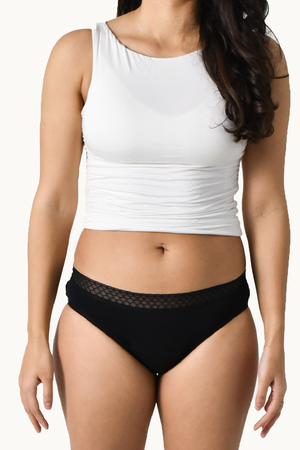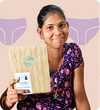Understanding your lady parts
The female anatomy often remains a mystery – even to us women 🥲 Our science textbooks and those hurried-through lectures in 7th grade might not have helped but hopefully, this article does :) Think of this article as a quick personal dictionary to your lady parts! 📖 Female anatomy includes both external genitals, known as the vulva, and internal reproductive organs like the ovaries and uterus. Interestingly, despite physical differences, all sex organs originate from the same group of cells during foetal (AKA fetal) development, with a baby’s biological sex determined at conception! So first, we’ll break down the external anatomy 🌸 The external female anatomy comprises the pubis and the vulva. 1. Mons Pubis: The mons pubis, or pubic mound, is the fleshy area on the pelvic bone– Basically, where your pubic hair typically grows! 2. Vulva: The vulva (which most of us have wrongly been calling vagina) includes several parts: 👉🏼Labia Majora: The fleshy outer lips on either side of the vaginal opening, usually covered with pubic hair 👉🏼Labia Minora: The inner lips situated inside the outer lips, varying in size and sometimes extending beyond the outer lips👉🏼Clitoris: The tiny button-like fleshy part, is located where the inner lips meet, at the top. It varies in size from person to person. While only the tip is visible, it has two shafts extending inside the body up to 5 inches! It contains millions of nerve endings, which explains why it works like magic when you’re gunning for an orgasm! 👉🏼Clitoral Hood: The fold of skin surrounding the head of the clitoris, protecting it from friction. 🌱Now, the Internal Anatomy Here comes your reproductive organs – we’ll make it super easy, promise. 1. Vagina Most women refer to their vulva as ‘vagina’ but the vagina is a canal connecting the vulva to the uterus. It averages 2.5 to 3 inches in length but expands during arousal. Glands located on either side of the vaginal opening, secrete lubrication to keep the vaginal tissues moist 💦 2. Cervix The cervix is the lower portion of the uterus, a cylindrical tissue separating the vagina from the rest of the uterus. It dilates during childbirth to allow the baby to pass through the vagina😯 3. Uterus The uterus, located in the middle of the pelvic cavity, is a muscular sac that houses the foetus during pregnancy. During the menstrual cycle, its lining thickens with blood in preparation for a fertilised egg. If pregnancy does not occur, the lining sheds, resulting in your period! 🩸 4. Fallopian Tubes The fallopian tubes connect the ovaries to the uterus. Eggs released from the ovaries travel down these tubes toward the uterus for potential fertilisation. An ectopic pregnancy, where a fertilised egg implants in the fallopian tube, is a medical emergency due to the risk of tube rupture ❗ 5. Ovaries The ovaries, egg-shaped organs about the size of almonds, are attached to the fallopian tubes on either side of the body. Most females have two ovaries that produce eggs and 2 suuuper important hormones – estrogen and progesterone. 🫧 (Check out our guide on hormones!) That’s it, folks! 🥳 The female anatomy is an amazing symphony of various organs working together for sexual function, reproduction, and hormone regulation. The shape and size of these organs vary naturally among women & each body might function slightly differently, maintaining regular exercise, diet and regular visits to the gynac are key to keeping your lady bits healthy and happy! 🍉 Sources: https://www.plannedparenthood.org/learn/health-and-wellness/sexual-and-reproductive-anatomy/what-are-parts-female-sexual-anatomy https://www.medicalnewstoday.com/articles/326898#breasts
Learn moreCan You Do Yoga During Periods?
Periods can be an emotionally and physically draining time of the month – the cramps are unbearable, the mood-swings, the cravings! This leads many to wonder if they should continue their regular exercise routines while bleeding 😮💨 The good news is, yoga can be a gentle and effective way to manage period symptoms 🧘🏻♀️ Here’s everything you need to know about practicing yoga during your period! Benefits of Doing Yoga on Your Period 🙅🏻♀️Alleviates Cramps: Certain yoga poses can help relieve the pain associated with menstrual cramps. Gentle stretching and poses that focus on the lower abdomen can ease tension and provide relief. 🤌🏽Reduces Bloating: Yoga can improve circulation and stimulate the digestive system, which helps reduce bloating and discomfort. 😌Boosts Mood: Hormonal changes during menstruation can affect your mood. Yoga promotes relaxation and the release of endorphins, which can help improve your mood and reduce stress. 🏃🏻♀️Increases Energy Levels: While you might feel more tired during your period, gentle yoga can help increase your energy levels by improving blood flow and reducing fatigue. Recommended Yoga Poses During Periods 👉🏼Child’s Pose (Balasana): This pose gently stretches the lower back and hips, providing relief from cramps and helping you relax. 👉🏼Cat-Cow Pose (Marjaryasana-Bitilasana): This gentle flow between two poses helps to massage the abdominal organs, easing cramps and promoting flexibility in the spine. 👉🏼Reclining Bound Angle Pose (Supta Baddha Konasana): This restorative pose helps open the hips and promotes relaxation, which can be especially comforting during your period. 👉🏼Forward Fold (Uttanasana): A gentle forward bend can help release tension in the back and neck and calm the mind. 👉🏼Supine Twist (Supta Matsyendrasana): This pose helps to stretch the spine and relieve tension in the lower back, which can be beneficial for period-related discomfort. Typically going for a more relaxing style, like Yin Yoga, is ideal during your period. If you’re worried how your period underwear could manage all these poses, without any leaks, we recommend the Hip Hugger or Lace Bikini. Both of these styles have padding all the way to the back, so you can Savasana in peace. Conclusion Yes, you can absolutely do yoga during your period! Yoga can be a gentle and effective way to alleviate menstrual symptoms, boost your mood, and increase your energy levels. Focus on gentle, restorative poses that promote relaxation🧘🏻♀️ But the most important aspect of practicing yoga during your period is to listen to your body. Every woman’s experience of menstruation is unique, and what feels good for one person might not be suitable for another. By practicing yoga mindfully, you can find relief and maintain a sense of well-being throughout your menstrual cycle 😌 https://www.arhantayoga.org/blog/yoga-and-period-practice-yoga-inversions-during-menstruation/ https://www.verywellhealth.com/yoga-poses-for-your-period-3567221
Learn moreWhy does my underwear stain even after washing?
You just bought a new pair of underwear, and wore them only a couple of times. But, why are there light, bleach-like patches showing up, even after a good wash? 🤔 Regardless of how often you wash them or how few times they’ve been worn, you might notice lighter areas in the crotch that look like they’ve been bleached. This isn’t due to a faulty washing machine or excessive wear – your vaginal discharge can actually bleach your underwear! Why Are There ‘Bleached’ Patches in Your Underwear? Your menstrual blood is a cocktail of blood, mucus, tissues, enzymes, proteins, etc! The vaginal discharge in it has a pH level that ranges from 3.5 to 7, leaning towards the acidic side. A healthy vagina produces more acidic discharge, but pH levels can vary due to factors like your sex life, hormones, and menstrual cycle. The vagina contains ‘good’ bacteria, like lactobacilli, which maintain the optimal acidity level to keep the vagina healthy and prevent bad bacteria from causing infections. This discharge increases during ovulation and pregnancy due to an increase in cervical mucus. When exposed to air, the discharge & blood can cause mild yellow or rusty brown stains due to oxidation. Guess what? It can also cause holes over time! 🫢 So having bleached patches on your underwear is quite normal and generally nothing to worry about, as long as you continue washing your period underwear thoroughly. Here’s a quick guide on the best way to do it! Is there something I can do to fix it? Honestly – not really. Enzyme-based cleaning products can help break down discharge stains, but ensure you use gentle cleaning products (avoid harsh cleaners!) to ensure they’re safe from any damage to the fabric! 🌸 When should you be concerned about discharge? If your discharge comes with: 😷 A rotten fishy odour🩸 Bloodstains, especially when you are nowhere near your period😖 Persistent irritation 🔥 Burning sensation❓Unusual colour/texture changes: green discharge or cottage cheese-like texture deserve professional attention as they may be signs of an infection. Your vagina is a delicate balance of enzymes & bacteria - the slightest change can upset this balance. Every cycle, every bleed is different too! While subtle changes in texture and colour are normal throughout the month, extreme bleaching on your period underwear might also be a sign to get your regular checkup done! 🏥 Sources: https://www.cheekypants.com/blog/everything-you-need-to-know-about-vaginal-discharge.html https://metro.co.uk/2019/05/24/vagina-leaves-bleached-patches-underwear-9672616/ https://cycle.care/en/afscheidingsvlekken-in-ondergoed-zo-krijg-je-ze-eruit
Learn moreHow to prevent rashes around your lady bits in summer!
Any vulva-owner knows that ignoring the health of your lady bits isn't always a hassle-free practice. Now crank up the heat & add pads to the whole process and it could possibly turn out to be a costly affair (quite literally)! But some no brainers & some.. Uh, brainers(?), might just make this summer a little easier on you, your menstrual & sexual health! 1. Water > Intimate Washes: We know what you’ve heard & seen – that your vulva needs to be cleansed with the “special wash” made specifically for it. But the honest-to-god truth is – No, you don’t absolutely need it. (We checked with our favourite gynac, dr_cuterus, too!) All you need to do is clean your vulva with warm water. If you still feel the need to use a wash, go for a mild, gentle wash, with no fragrances that could possibly irritate your skin! 2. Pick a breathable menstrual care product: Pads are 90% plastic. They’re basically made of synthetic materials that tend to trap moisture and heat, creating the perfect environment for bacteria to thrive. This causes even more irritation, itchiness, and rashes. As if pads hadn’t caused enough trouble already, summer can crank things up a notch. Switching from a plastic pad to soft, breathable period underwear (we have a few options), can make your periods easier to manage. At Nushu, we use bamboo fibre to keep things light & breezy (know why it works) allowing for ample air circulation. Bamboo also has natural antibacterial properties and is an excellent moisture-wicking fabric, which aids in avoiding excess moisture in your underwear! If you absolutely need to use disposable pads – make sure you dispose of each pad, every few hours to avoid buildup of heat and friction, and avoid wearing tight pants! 3. The Proper Wiping Technique: Didn’t think this existed, did you? When using the bathroom, always wipe from front to back to prevent the spread of bacteria from the anal region to the vulva. This simple hygiene practice reduces the risk of urinary tract infections (UTIs) and other genital infections. Use soft, unscented toilet paper and avoid dabbing too briskly! 4. Change out of that swimsuit (or sweaty clothes) ASAP! Whether it's sweaty workout clothes or a wet swimsuit, prolonged exposure to moisture can act as a breeding ground for yeast infections, bacterial overgrowth, and skin irritation in the vulvar area. Pack a spare set of underwear and clothing when you go for a swim next time. 5. Practise safe sex & always pee after: Unprotected sex can amplify the risk of UTIs. So do several lubricants available. Your safest bet is to opt for water-based lubes that are the easiest to wash off, ensuring no remnants are left behind to irritate you down there! Friction caused during sex facilitates the spread of bacteria in the urethra, making you more susceptible to UTIs. Peeing after sex ensures that germs from your urethra are flushed out. Conclusion: By following these basic hygiene practices, you can enjoy an infection free summer down there! Listen to your body's cues and seek medical attention if you experience persistent discomfort, unusual discharge, or signs of infection. With proactive self-care and awareness, you can nurture your vulvar health and embrace comfort and confidence in your daily life.
Learn moreWomen's Health: A Silent Crisis, with hope for the future
WHO declared “acceptability” & “gender sensitivity” as core components to right to health. Yet, it's a proven fact that women across the globe do not get equal access to healthcare. It's a silent crisis that's been going on for ages, but it's time to bring it into the spotlight. Because ignoring women's health isn't just unfair – it's downright dangerous. Unveiling the Neglect: Historical Oversights: For centuries, medical research has mostly focused on men. Yep, you heard that right. Women were often left out of clinical trials and studies, leading to a big gap in understanding their health needs. It's like trying to solve a puzzle with missing pieces. Not-so-fun-fact: Even something as basic as car seatbelts, are typically not designed with the female body in mind, leading to a 17% higher likelihood of women dying in car crashes compared to men. Stigma and Shame: Ever noticed how women's reproductive health gets swept under the rug? It's like there's this unspoken rule that certain topics – like periods or menopause – are too embarrassing to talk about. But guess what? Ignoring them won't make them disappear. It just makes it harder for women to get the help they need. And not to mention the serious bias several unmarried women face when it comes to accessing sexual & reproductive healthcare. Stigma around pre-marital sex & a woman’s agency over her own body makes it difficult for women to address possible health concerns & symptoms, without the fear of judgement from doctors or family. Pain Bias: Here's the kicker: when women do speak up about their health concerns, they're sometimes brushed off. Their pain is downplayed, their symptoms dismissed. It's like their voices aren't being heard. Every woman has heard the same old “Period pain hi toh hai, it's nothing serious''. And that can lead to misdiagnosis or delayed treatment, which nobody wants. Discrepancy in Research Funding: Want to know something shocking? Despite all this, research funding for women's health is often peanuts compared to other areas. It's like saying, "Sorry, your health isn't worth investing in." Not cool, right? Lack of medical awareness on Menopause Globally, numerous medical school curriculums still lack Menopause training (with a 2021 study revealing that 41% of surveyed medical schools didn't offer it). Menopause also carries substantial economic consequences, such as reduced productivity during what is often the peak of a woman's career, due to employer misunderstanding and policy gaps. Cervical Cancer In India, cervical cancer accounts for around 6% to 29% of total cancer cases among women. 17% of all cancer-related deaths in women aged 30 to 69 years, are due to Cervical Cancer. Commonly used plastic pads contain Phthalates & Volatile Organic Compounds (VOCs) (carcinogenic substances), that are easily absorbed through the vaginal lining and may cause a host of issues ranging from hormonal imbalances to Cervical & Ovarian cancer. All the more reason to switch to safer alternatives when you can. Period Underwear is slowly & steadily becoming a preferred menstrual care product for many women. Not only are they better for your health, safe & hygienic, but also significantly better for the planet! Wait… there’s a silver lining: Fem-Tech businesses are steadily headed towards a brighter future, with more investments starting to flow in (pun intended). The Fem-Tech industry is forecasted to achieve a market value of US$ 5.0 billion by 2033, with a projected compound annual growth rate (CAGR) of 15.2% from 2023 to 2033, according to a press release from Future Market Insights, Inc. One such innovative Fem-Tech startup, that we thought has been doing some REALLY cool stuff – NextGen Jane – is pioneering the development of a smart tampon system. The core technology behind NextGen Jane's smart tampon system is the detection of biomarkers in menstrual blood to provide valuable information about a woman's health, including fertility, hormonal imbalances, gynaecological conditions, etc. So far, NextGen Jane, has raised over 19.7M USD in over 6 rounds of funding and have been featured in various media outlets for its groundbreaking work in the Fem-tech space. Where do we go from here? While systematic change – changing attitudes & bias towards women’s health might take years to change completely, what we can do for ourselves is to DEMAND what we deserve. While having access to good healthcare is also a matter of privilege, we must do everything to make our voice heard. Choose better alternatives where you can — switching to better menstrual care products is not the last mile, yet it is a significant step!
Learn moreThe Female Hormones You Need To Know
One of the great mysteries of our bodies, hormones are responsible for a lot more than we give them credit (or blame!) for. We’ve all been told that they’re important, we might even know a few of the hormones that affect us, but we are often not sure what they do or how they impact health and wellness. Hormones are the body's messengers, produced in the endocrine system. They are secreted into the blood and carry vital information to organs and tissues. Put simply, when the hormones are out of whack, so are you. Now, let’s learn a bit more about what these female hormones are and how they affect your mind and body. Estrogen The primary female hormone, estrogen, is produced mainly in the ovaries. It is responsible for functions like ovulation, menstruation, breast development, and increasing bone and cartilage density. In the brain, it boosts the function of neurotransmitters that affect sleep, mood, memory, libido, and cognitive factors such as learning and attention span. On the other hand, it reduces the perception of pain, preserves bone mass, and increases HDL – the good cholesterol. When in excess, it can cause depression, weight gain, headaches, low sex drive, anxiety, sleep trouble, and menstrual problems. Too little of it can be responsible for menstrual problems, fertility issues, and mood disorders. Progesterone Like estrogen, progesterone is majorly associated with the female reproductive organ. It helps prepare the uterus for pregnancy and helps stabilize menstrual cycles. Levels of this hormone affect how regular your periods are, your mood and sleep cycle. Low progesterone levels can cause heavy or irregular menstrual periods and fertility problems. If progesterone levels drop during pregnancy – meaning your uterus is not prepared enough for the egg – it can cause premature labor or miscarriage. Progesterone deficiency can cause vaginal dryness, depression, insomnia, yeast infections, hair loss and more. Testosterone Predominantly a male hormone, it affects women’s health as well and is one of the principal androgens (types of male reproduction hormones) present in the body. This hormone contributes to sex drive, fat distribution, muscle strength, bone mass, and red blood cell production in both men and women. Women who have too much testosterone may have thinning hair on their heads, excess body hair, facial hair, acne, more body fat, low libido, and smaller breasts. Having high testosterone can also cause irregular periods and contribute to fertility problems. Human Chorionic Gonadotropin (HCG) Also known as the pregnancy hormone, HCG is yet another hormone that is produced naturally in women. It’s produced by the placenta during pregnancy and is found in the urine or blood around 10 to 11 days after conception (when a sperm fertilizes an egg). Hence, testing for HCG in blood or urine is a way to determine if you’re pregnant! They also affect your mood during this time by making you irritable, restless or anxious. Follicle-Stimulating Hormone (FSH) The Follicle-Stimulating Hormone is produced by the pituitary gland, in both men and women and regulates the functions of both the ovaries and testes. It plays an important role in sexual development and functioning. FSH helps control the menstrual cycle in women and stimulates the growth of eggs in the ovaries. Throughout the course of the menstrual cycle, the FSH levels change and it's the highest during ovulation. Lack or low levels of it can cause loss of fertility and poor ovarian functions. Luteinizing Hormone (LH) Released in the pituitary gland, LH has different roles in the two halves of the menstrual cycle. In weeks 1-2 of the cycle, it stimulates the ovarian follicles to produce the female sex hormone, oestradiol. Around day 14 of the cycle, a surge in luteinising hormone levels causes the ovarian follicle to rupture and release a mature oocyte (egg) from the ovary, a process called ovulation. If a woman conceives, LH also supports the early stages of pregnancy. High levels of LH can result in PCOS and low levels can cause irregular periods or difficulty in ovulation. Prolactin Another product of the pituitary gland, prolactin’s main jobs are to govern egg release and stimulate breast-milk production in new moms. Although rare without pregnancy, high levels of prolactin can reduce sex drive and even bring on menopause-like symptoms. Post-childbirth, normal levels can help you reduce weight faster as well. Besides these, there are other hormones that affect your body and mind like cortisol, Dehydroepiandrosterone (DHEA), adrenaline and more. A quick call with a doctor or research on the internet can help you discover more about yourself!
Learn more















